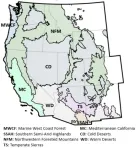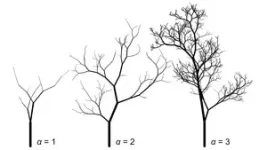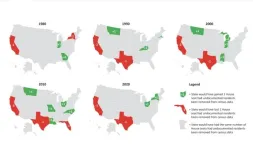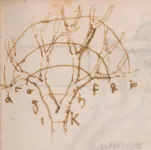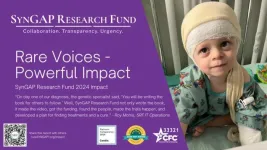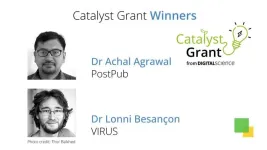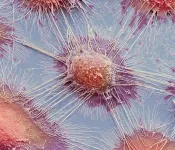(Press-News.org) A study shows that there are almost twice as many risky days for large human-caused fires in the American West as there are for lightning-caused fires, due to differences in the level of heat and aridity under which each type of fire is likely to occur. The discrepancy is not accounted for in most fire early warning systems. In addition, risky days for human-caused fires are growing faster than risky days for lighting-caused fires as the climate warms.
Fa Li and colleagues focused on Vapor Pressure Deficit (VPD), which captures both dryness and heat, reflecting the difference between the actual air water vapor content and saturation. The authors used a Bayesian inference algorithm to model the relationship between VPD and the probability of large fires for the largest 10% of fires in each ecoregion in the western United States. The estimated VPD threshold for large fires ranged from 1.1 to 2.1 kPa for human-ignited large fires and 1.8 to 3.1 kPa for lightning-ignited large fires. One reason for this difference is likely related to the location of the first ignition. Lightning strikes from above, hitting the forest canopy, which is often living and therefore moist. Human-caused fires often ignite at ground level in dried grass or fine dead branches, material which tends to be very dry. Thus human-caused fires can catch and spread when the atmosphere is wetter. Across the west, from 1979-2020, about 30 days a year were sufficiently hot and dry for lightning-ignited large fires, while about 58 days a year were sufficiently hot and dry for human-ignited large fires. The number of flammable days for human-caused fires increased 21% more rapidly than the number of flammable days for fires caused by lightning over the same period. Anthropogenic greenhouse gas emissions were responsible for 81% of the increases in human-related flammable days. According to the authors, the results can help build more accurate models of fire risk.
END
Human-caused fires growing faster than lightning fires in the Western US
2025-02-11
ELSE PRESS RELEASES FROM THIS DATE:
Barbeque and grandma’s cookies: New study looks at nostalgia, comfort in food preparation for older adults
2025-02-11
PULLMAN, Wash. — Foods that evoke a sense of nostalgia and comfort and have good texture variety are important considerations in prepared meals aimed at older adults, according to new Washington State University research.
“We want to help the prepared food industry produce appetizing, healthy meals for older adults,” said Carolyn Ross, professor in WSU’s School of Food Science. “Malnutrition is quite prevalent in people over 60 because food may be available, but they won’t eat it if they don’t like it. We want to walk a line where food is tasty, convenient, and full of nutrients.”
In a paper recently published ...
The political consequences of undocumented residents in the census
2025-02-11
In recent years, some public figures have argued that undocumented residents in the United States should not be included in census data used for congressional apportionment because their inclusion unfairly benefits Democratic-leaning states. John Robert Warren and Robert E. Warren analyzed data from every census from 1980 through 2020 and used high quality state-level estimates of the size of the undocumented resident population at each time point. The authors then calculated how many House seats and how many Electoral College votes would have changed had undocumented residents been excluded from the data after each census. Previous efforts to ...
Purity and environmental concern
2025-02-11
Attitudes about climate change and carbon footprints show strong regional patterning. Farzan Karimi-Malekabadi and colleagues investigated the role of moral values in these geographic patterns. The authors used Moral Foundations Theory, which posits that moral judgements emerge from deeply held intuitions about care, fairness, loyalty, authority, and purity. The authors used opinion surveys, comprising 12,061 respondents, conducted from 2008–2013 that measured beliefs regarding the reality, human causation, and negative impacts of climate change, as well as estimates of household carbon footprint provided by UC Berkeley CoolClimate Network. This data ...
Branch patterns in trees and art
2025-02-11
The math that describes the branching pattern of trees in nature also holds for trees depicted in art—and may even underlie our ability to recognize artworks as depictions of trees.
Trees are loosely fractal, branching forms that repeat the same patterns at smaller and smaller scales from trunk to branch tip. Jingyi Gao and Mitchell Newberry examine scaling of branch thickness in depictions of trees and derive mathematical rules for proportions among branch diameters and for the approximate number of branches of different diameters. The authors begin with ...
Researcher develops method to measure blood-brain barrier permeability accurately
2025-02-11
For decades, scientists across the globe have investigated methods to accurately measure drug permeability across the blood-brain barrier, a compact layer of cells that protect the brain from potentially dangerous substances and microbes. They struggled with a number of parameters, such as blood flow and binding to plasma proteins, which were shown to impact permeability in different ways.
In research published in the December 2024 issue of Fluids and Barriers of the CNS (“Brain endothelial permeability, transport and flow ...
SynGAP Research Fund dba cure SYNGAP1 (SRF) announces the release of their SYNGAP1 impact report for 2024
2025-02-11
Mill Valley, CA – February 11, 2025 – The SynGAP Research Fund 501(c)(3) dba Cure SYNGAP1 proudly announces the release of its inaugural Impact Report, a transparent and celebratory reporting of tangible goals achieved and purposeful progress made in 2024 by this growing and dynamic organization led entirely by families and driven by volunteers. With a mission rooted in improving the lives of SYNGAP1 patients, and built upon the promises of Collaboration, Transparency and Urgency, SRF’s 2024 Impact Report provides stakeholders – including families, scientists, and donors ...
Breakthrough in click chemistry: innovative method revolutionizes drug development
2025-02-11
Middle molecules with a molecular weight of more than 1,000 are difficult to synthesize due to multiple steps and time-consuming nature, demanding the development of a new approach that can overcome these disadvantages. Click chemistry has become an essential tool in applied chemistry due to its simplicity, efficiency, and versatility. This approach to chemical synthesis allows for quick and reliable joining of small molecules into larger, more complex structures, often with minimal side reactions and byproducts. By definition, click chemistry reactions are highly selective and efficient, making them ...
Digital Science announces Catalyst Grant winners, rewarding innovations to safeguard research integrity
2025-02-11
Digital Science has awarded its latest Catalyst Grants to two innovative teams, supporting their technology ideas aimed at safeguarding research integrity and strengthening trust in science.
The winners will use the funding and mentorship from Digital Science to develop their ideas, both of which include enhanced dashboards – visualizations based on available data – to flag retracted or questionable research papers.
The winning applications from Digital Science’s 2024 Catalyst Grant round announced today are:
PostPub ...
How cancer cells trick the immune system by altering mitochondria
2025-02-11
The immune system plays a key role in detecting and destroying cancer cells. Cancer immunotherapy works by programming immune cells to recognize and eliminate cancer cells. However, many cancers can escape immune surveillance through various mechanisms, resulting in resistance to treatment. This highlights the need to better understand the molecular processes that enable immune evasion.
The tumor microenvironment (TME)—the space surrounding a tumor—plays a critical role in interactions between cancer and immune cells. Cancer cells can reshape the TME to ...
Poll: Most U.S. workers with chronic conditions manage them at work, haven’t told employer
2025-02-11
Embargoed for release: Tuesday, February 11, 2025, 6:00 AM ET
Key points:
More than half of employees in the U.S. (58%) report having physical chronic health conditions, such as hypertension, heart disease, diabetes, and asthma, according to a new nationally representative survey.
Three-fourths of U.S. employees with chronic conditions (76%) need to manage their conditions during work hours, yet a majority (60%) have not formally disclosed their conditions to their employer.
More than one-third of U.S. employees with chronic conditions (36%) say they have skipped medical appointments or delayed getting care to avoid ...
